QUEST TAUNT WARRIOR DECK LIST GUIDE
- Last updated Apr 18, 2017 (Un'Goro Launch)
- Edit
- |
Wild
- 18 Minions
- 10 Spells
- 2 Weapons
- Deck Type: Ranked Deck
- Deck Archetype: Taunt Warrior
- Crafting Cost: 6640
- Dust Needed: Loading Collection
- Created: 4/10/2017 (Un'Goro Launch)
- Daolh2610
- Registered User
-
- 4
- 19
- 28
-
Battle Tag:
N/A
-
Region:
N/A
-
Total Deck Rating
130
Our Un’Goro Quest Fire Plume’s Heart Taunt Warrior deck list guide will teach you how to pilot this popular Season 37 deck! Our guide features mulligan, play, and card replacement strategies!
Introduction
Quest Taunt Warrior is a variation of Control Warrior that instead of the standard late game “grind the opponent out” game plan takes a more proactive approach with the new Quest – Fire Plume's Heart which provides tons of fire power once the Quest is done.
Taunt Warrior turned out to be one of the most powerful, if not THE most powerful decks in the current meta. According to the early statistics, the deck has a nearly 55% win rate in Legend. While the meta might still shift, it seems that Taunt Warrior will be a force to reckon with, as it’s solid against slow and fast decks alike.
The lists I’m using here was posted by reddit user “shadohead” on /r/hearthstone yesterday – he peaked in top 20 Legend with it. The “best” list is still up in the air and it’s the one I have most experience with, If you prefer to play the Sjow’s #1 Legend list, you’re just few changes away – you can find it here. Honestly the only big difference is Dirty Rat vs Armorsmith. If you face more Aggro, Armorsmith will be a better option, however it seems that the Legend meta I’m facing is pretty control-heavy right now and Dirty Rat performs better in those matchups. I’ll talk about it more in the “card substitutions” section.
Quest Taunt Warrior Mulligan Strategy & Guide
I’ll divide the mulligan section into two – against fast decks and against slow decks. Fast decks are generally the Aggro decks (e.g. Pirate Warrior) or high tempo Midrange decks (e.g. Midrange Hunter). Slow decks are slower Midrange and Control decks.
VS FAST DECKS
Higher Priority (keep every time):
- First things first – Fire Plume's Heart. If you’re sure or at least almost sure that you’re facing an Aggro deck, you want to mulligan your Quest away. It doesn’t help in those matchups, most of the games are decided before you finish it. You win those games by stabilizing the board and then putting a huge Taunt wall they can’t pass. Quest means that you start with one less card, which makes your early game more inconsistent. However, if you aren’t sure that your opponent plays Aggro – e.g. you face Warrior and it’s about 50/50 to be Pirate or Taunt, you need to keep the Quest. Starting with 1 less card against Aggro hurts, but doesn’t immediately lose you the game. Starting without the Quest against Control pretty much loses you the game on the spot. I’m still on the fence when it comes to Midrange matchups – from my experience it seems that in some it’s worth to keep it (e.g. against Shaman or Paladin), but against the more aggressive Midrange decks it’s not worth it (e.g. Midrange Hunter – you can’t drop that Armor Hero Power unless you’re really high on health or they will put you on the clock and kill you).
- Fiery War Axe – The best early game card vs Aggro decks. Before you start putting up a serious wall, you need to control the early game. If you get overrun on the first turns, your Taunts aren’t going to be enough. That’s why FWA is amazing.
- Slam – While not as good as FWA, it’s another early game control tool. You can use it to get rid of their 2 health minion or combo it with Whirlwind to kill the 3 health guys. You don’t need to get the extra card draw, killing an early drop is most important.
- Ravaging Ghoul – 3/3 with a Whirlwind mechanic, it’s one of the best minions against Aggro – while sometimes the effect doesn’t deliver, more often than not you’re clearing 1-2 small minions with it AND you put a body on the board.
- Tar Creeper – Best anti-Aggro Taunt, 3/5 for 3, while not impossible to pass through, will cost your opponent some resources. They usually have to bump 2-3 minions in or use some burn that would otherwise hit your face.
Lower Priority (keep only if certain conditions are met):
- Whirlwind – Alone you can keep it against the decks that run some early 1 health minions – e.g. Pirate Warrior. Whirlwind can get a lot of value in those matchups. However, you can also keep it with Sleep with the Fishes for a 4 damage AoE – that’s usually more than enough to clear early boards against Aggro Druid or Zoo, where Whirlwind alone is not good enough.
- Dirty Rat – Against Quest Rogue. Pulling out a bouncer or the minion they’re bouncing from their hand can be auto-win. However, it’s risky to keep against Rogue, because Miracle plays cards you don’t really want to pull out (like Arcane Giant).
- Acolyte of Pain or Stonehill Defender – Generally these are value minions, so they don’t accomplish too much against Aggro. However, I like to keep them against the decks that don’t rush me down that hard and the extra card might come handy – e.g. in Midrange matchups or against Zoo.
- Bloodhoof Brave – It’s a really good card, but you want to keep a 4-drop in the Aggro matchup only if you already have a good curve. E.g. if you already have a 2 and 3 mana play. Or if you have FWA and you’re on Coin (then you can use it as a 3-drop).
- Brawl – I’m still 50/50 about keeping the Brawl in some matchups. It’s definitely NOT a keep against something like a Pirate Warrior. But against Aggro Druid or Zoo Warlock, turn 5 Brawl might be a game changer. On the other hand, you reduce your chance to draw your FWA or another early game play by keeping a 5 mana card.
VS SLOW DECKS
Higher Priority (keep every time):
- If you face a slower Midrange deck, Control deck, or basically any deck where the game will most likely get to the late game, you KEEP your Quest (Fire Plume's Heart) every time. It’s your main win condition and while you can sometimes win with just your minions, it’s significantly harder and close to impossible in some matchups.
- Fiery War Axe – Even against slower decks, Fiery War Axe is always a keep. It’s great early game board control tool. You want to stall the game until you finish the Quest and FWA means that the early game won’t spiral out of control for your opponent.
- Slam – Just like vs Aggro, you want to keep Slam, but this time around it has a bit different purpose. You don’t want to use it to kill a minion, but to cycle. It will help you with some early game trades and it usually cycles itself around turn 3-4.
- Acolyte of Pain – More card draw. You want to keep card draw. Card draw is great. It’s even better if you can hide it behind the Taunt, then you can pick the right targets or play some Whirlwind effects and gain multiple draws.
- Stonehill Defender – MVP in slow matchups. Not only is it a cheap way to get +1 for your Quest, but it also gives you another Taunt. It can give you another copy of itself (you should pick it if you hand is low on Taunts) or something to fix your curve. You want to play a Taunt every turn, so let’s say that you don’t have anything for 4 and you have a 5-drop in your hand already, you just pick 4 and you’re happy. Of course, sometimes you end up with a bunch of bad options, but it rarely happens.
Lower Priority (keep only if certain conditions are met):
- Tar Creeper – I keep it when I don’t have Stonehill Defender. Generally, defender is a better turn 3 play in slow matchups (because you can fix your curve, like I’ve mentioned before), but if you don’t have it, you don’t want to skip your curve. Also, Tar Creeper might be better against certain cards like Northshire Cleric or Acolyte of Pain, because even though you can’t attack for 3, they can’t farm it for the cards, unlike Stonehill.
- Ravaging Ghoul – I like to keep it in a few cases. E.g. if your opponent might have some 1 health minions (rare against Control, but e.g. Exodia Mage runs multiple 1 health minions). Or if your opponent runs some 4 health minions and you have Fiery War Axe in your hand. Or if you have Acolyte of Pain in your hand – if it doesn’t die right away, you can follow it up with Ghoul for an extra card.
- Bloodhoof Brave – If you have the curve. It’s not like 4-drop is too slow, but you generally want to curve out even in the slower matchups. You want to try to play at least one Taunt every turn.
Quest Taunt Warrior Play Strategy
Taunt Warrior is a very interesting deck, because it has two stages of gameplay. First one is before you finish the Quest and the second one is after you do that. In the first phase, it’s one of the most reactive and defensive decks in the game. I don’t remember ever rushing anyone down, which sometimes even happened with old Control Warrior if you got a really good hand and curve. Most of the minions in your deck are Taunts, which are great on defense, but suck on the aggression. They have low amount of attack and high amount of health. Most of them have 1-3 attack – you run only two minions with 4 attack and that’s the highest in your deck. Besides Taunts, most of your deck is cycle and removals, so you won’t put pressure.
However, everything changes once you finish the Quest. Your deck is still very defensive, but your Hero Power isn’t. Now you throw an 8 damage ball of fire every turn and start putting lots of pressure on your opponent. You basically turn the whole game around – now you’re the one that wants to close out the game as quickly as possible while filling the board with defensive minions that protect your health.
This two stage gameplay makes playing this deck a really cool experience and it’s exactly what makes it powerful – you can run fully reactive deck and still have a solid late game win condition.
Vs Aggro
When you play against Aggro, you can drop the “Quest” part from the deck’s name. If you’re sure that you face a fast, aggressive deck, then you most likely want to mulligan your Quest away (it’s really cool that you have an option to do so!). It’s pretty useless for two main reasons. First one is that it’s too slow – you won’t realistically finish it before turn 8-9 and many of the Aggro games don’t even last that long. And second is that it’s not necessary. If the game hasn’t already ended by the time you finish it, it’s for two possible reasons. First – it took you really long to stabilize and you’re still in the “I’m trying to survive” phase, then the Quest is useless, because you don’t want to spend mana on a 8 damage Hero Power, you want to Armor up to get out of burn range. Second – You’ve already stabilized, you have put a Taunt wall, but your opponent is still trying to fight. In that case, Quest reward would definitely speed up the game (probably force an instant concede), but it’s not necessary. It’s a game you pretty much can’t lose – your opponent can’t get through all the Taunts and you gain +2 health every turn, getting further and further away from the burn range. So basically, against Aggro you play a Taunt Warrior, not Quest Taunt Warrior.
In faster matchups, there is only one goal – survive. You don’t want to kill them, you don’t want to pull any crazy or funny combos, you just put a wall and not let get them through. From my experience, first 3-4 turns are most important. That’s where your deck is weakest and their deck is strongest. They will try to abuse that fact and rush you down before you play a big Taunt after big Taunt. You basically want to use everything possible to keep the board clear. Fiery War Axe is obviously the best tool for that, but Whirlwind effects (especially Ravaging Ghoul) or Slam are also solid.
Tar Creeper is your best friend vs Aggro. It’s a 3 mana 3/5 Taunt, what more should I say? They will most likely get through it, but will usually have to trade some minions, which is exactly what you want. Even though Acolyte of Pain is pretty slow, it’s very effective against boards with multiple small minions. Card draw is good, because it brings you closer to the cards you want to get. That’s why if I can choose between Stonehill Defender and Acolyte, I play Acolyte – you already have a lot of Taunt minions in your deck, what you want is getting that Sleep with the Fishes or Brawl to stabilize first.
Talking about stabilization. Sleep with the Fishes is absolutely busted against Aggro if you have Whirlwind effect to combo it with. It’s a 4 damage AoE which, most of the time, clears the whole board. Pulling it off on turn 3 (or turn 5 with Ravaging Ghoul) will often turn the whole game around. Brawl is also solid if they have flooded the board. Anything to get as much damage off the board as possible.
Generally, try to FIRST clear the board and then play Taunts, not vice versa. When you play Taunt, your opponent chooses how he wants to deal with it. He will pick the best trades, help himself with weapons/burn and it shouldn’t be that hard to get through. But if you clear the board first and then play a Taunt on a nearly empty board, it will be much harder to kill and provide a much better protection.
Be careful when playing Dirty Rat vs Aggro. You should NOT play Dirty Rat on turn 2 unless your hand is really terrible and you have to take the risk. The only situation where you might play it is when you have an Execute ready in your hand. For example, Bittertide Hydra is a pretty common card in Aggro and pulling it out on turn 2 is game over unless you Execute it right away after it trades with the Rat. However, Dirty Rat is a great card in the mid game, when you’ve already stabilized or you’re close to. Opponents are often keeping minions to not play into Brawl – if you play to play the Brawl, you can drop the Dirty Rat first. You can also pull out a Charge minion they’re keeping – it’s better if you can deal with it on your own terms. At the same time, around turn 5-6, Aggro deck might be out of minions and Dirty Rat is just a 2 mana 2/6, which is great.
After the mid game, when tempo is no longer that important, try to Hero Power every turn if you’re pretty low on the health. After you put a Taunt wall, pretty much the only way they can kill you is with burn damage. If you get above 10, you should be safe against pretty much anything.
Vs Control
Games vs Control are much more interesting than those against Aggro, because you can actually use your Quest reward. And that’s pretty much your main goal of the slower matchups – you want to get to your Quest reward as soon as possible. Taunts are great at stalling, but they easily get outvalued by the “normal” big drops. It basically means that you’re racing against time – if your opponent outvalues you, you get your reward too late, he has a board and card advantage, even the Rag Hero Power might not help you.
Finishing a Quest is your long term game plan since turn 1. You obviously keep it every time. Then, you try to curve out with Taunts. For example, one of the best possible curves might be turn 3 Stonehill Defender, turn 4 Bloodhoof Brave, turn 5 Direhorn Hatchling, turn 6 2x 3-drop Taunt (e.g. 2x Tar Creeper, turn 7 The Curator. Now you can play a small Taunt, finish the Quest and get advantage of the reward right away. Of course a perfect curve won’t always happen, not to mention that you often have to use removals or draw cards in between playing Taunts. But you should expect to finish the Quest around turn 9-10, if you do it later, it might be too late.
Since you aren’t under a lot of pressure, you can plan your removals, especially AoEs carefully. For example, one common tactic is to play Taunt after Taunt every turn, letting your opponent kill them while they still develop the board and then clearing everything with Brawl or Sleep with the Fishes right before/right after finishing the Quest. For example, you don’t care about losing on the board if you finish the Quest and have Brawl in your hand. You can fall behind, but you’ll still be safe, because of the Taunts and on turn 10 you can Brawl, play the Quest reward and Hero Power right away. Depending on the Brawl and Hero Power outcome, you should clear the whole board and be in control, since now you have a much stronger Hero Power. Try to save the Brawl for after the Quest, but of course if you’re completely overwhelmed by the board, you can use it before.
Remember that the deck is very low on Armor gain. It doesn’t run Shield Blocks, so basically after you finish the Quest, your only way to gain health is Alley Armorsmith. Your opponents will know that they can’t afford the long game and they will try to face rush you after you finish the Quest. So it’s only in your best interest to go into your Quest turn with as high health as possible. If you’re really low, but you’re ahead on the board, you might consider waiting a bit and Armoring up for a few turns. You don’t want to die to random burn just because you can’t heal yourself. I won some games vs Elemental Shaman just because I’ve waited 2-3 turns with the Quest and got out of range of the Blazecaller + Kalimos, Primal Lord burn range.
Primordial Drake + Sleep with the Fishes is a great late game power play. It’s like an Abyssal Enforcer on steroids – you put a 4/8 Taunt and deal 5 AoE damage. It’s a great comeback combo.
Battle Rage is great in slower matchups. You have a lot of high health minions, so it’s only natural that they might survive. Getting 2 cards Battle Rage is already worth it, but with this deck you can get 3-4 card draws for 2 mana quite often. You’re losing a lot of value on your Taunts, so having a way to refill the hand can be lifesaving.
Dirty Rat in slow matchups is quite interesting. Generally, you don’t want to play Rat on turn 2. Your best Rats come a) when you’re ahead on the board and you can trade into whatever comes out, b) you have Execute in your hand to deal with a potential big threat right away or c) you play it right before the AoE turn (or into the opponent’s Doomsayer). The card is great in slow matchups for a few reasons. First, it’s a 2 mana Taunt for the sake of the Quest. Second, your opponent will likely try to not play into AoEs and you can force him to. Third, slower decks often hold onto some cards to get the best use of them – e.g. if you can pull out a minion with powerful Battlecry and kill it on your own terms, it’s great. Fourth, it disrupts some combo decks, like the Exodia Mage – pulling out Antonidas and killing it is pretty much 100% win for you.
General Tips
- Don’t be too greedy with your Stonehill Defender picks. I’ve seen some people auto-picking the biggest guy and it’s not always correct. You generally want to pick a minion to fill your curve. If there is no such an option or you don’t need to fill the curve, generally try to pick some cheaper stuff. Against Aggro you need the tempo (although Alley Armorsmith is generally also a great pick, as it gives you extra Armor) and against Control you don’t need to play huge Taunts – you want to finish the Quest as soon as possible and often that 2-3 mana Taunt is exactly what you need to do that. Picking a huge thing is good if you’re nearly out of cards, but if you’re still doing the Quest, I could see picking let’s say Pompous Thespian over Soggoth the Slitherer.
- Remember that your Sleep with the Fishes are pretty poor without a Whirlwind effect, so if possible, try to save at least one to combo with them.
- Try to play The Curator as soon as possible, so you minimize your chance to draw your Dragon and Beasts.
- If you plan to trade Direhorn Hatchling anyway, do it before you play The Curator – this way you have a chance to draw the 5 mana 6/9 Taunt right away. It’s a huge tempo play.
- Sometimes it’s worth it to enrage your own Bloodhoof Brave to make it trade better. E.g. if your opponent has a 6/5 minion on the board, it might trade into the 2/6 with ease while still surviving at 3 health. But if you turn that Taunt into a 5/5, it now trades 1 for 1.
- If you need some instant cycle, you can potentially draw a lot of cards in a single turn with a combination of cards like Acolyte of Pain, Slam, whirlwind effects and Battle Rage. E.g. Acolyte of Pain + Slam + Battle Rage cycles 4 cards assuming that your Hero is damaged (+1 more after Acolyte takes the final hit). You can also play a bunch of cheap minions, use Whirlwind and Battle Rage for 3-4 cards.
- Remember that Sleep with the Fishes deals damage to the WHOLE BOARD, including your minions. It means that, if possible, play your minions AFTER Sleep with the Fishes or try to keep the ones you don’t want to get heavily damaged at full health before using the card.
- Be careful with the Executes, especially in the slower matchups. Without Shield Slams, you run only 2 hard removals as opposed to 4. Try to use the Execute as the last option, if you can trade the minion with your own minions, weapon, Slam etc. quite efficiently, you should generally do that first.
Quest Taunt Warrior Card Substitutions
Surprisingly, Taunt Warrior isn’t that expensive of a deck. It runs no Legendaries besides the Quest itself (The Curator is an adventure Legendary, so it’s a bit different). The main problem is that it runs a lot of Epics, and crafting Epics might be even more problematic than crafting Legendaries, because they are rarely used in a variety of decks. Here are the most expensive cards from the deck and their potential replacements.
- Fire Plume's Heart – If you don’t have the Quest, playing Taunt Warrior is pointless. You should look for some classic Control Warrior list instead, but it’s probably much weaker in the current meta.
- Dirty Rat – While I seriously think that Dirty Rat is one of the best tech cards in the current meta and that it’s worth crafting, I understand that someone might not have it. Then you probably want to play Armorsmiths instead. Actually, you might want to play Armorsmiths even if you have Dirty Rats. It really depends on the decks you face. Armorsmiths are better against fast decks, e.g. Pirate Warrior, Aggro Druid, Midrange Hunter, Zoo Warlock. At the same time, Dirty Rat is better against Control/Combo decks, like mirror matchups, Control Priest, Exodia Mage or Quest Rogue.
- Sleep with the Fishes – The card is really amazing and you’ll really perform much worse if you don’t play it. The problem is that there is no direct replacement. If you’re missing one, you should play second Brawl (which is also an Epic, but at least a Classic one that was played pretty much since the Beta). If you’re missing both, Armorsmith is also a solid option. Alternatively you can try Shield Block for some extra Armor gain + cycle, but I would really recommend just crafting it.
- Brawl – You absolutely need at least one copy, it helps so much, it can’t really be replaced.
- The Curator & Primordial Drake – Those come in a package. If you don’t have one, you don’t want to play the other. I would say that those are also pretty crucial for the deck, Curator generally draws you 1-2 cards (1.5 on average) while being Taunt himself and Primordial Drake is a good late game AoE with a big body. However, they aren’t 100% necessary for the deck to function. You can replace them with other late game Taunts. Ornery Direhorn and Tar Lord are okay budget options. Bog Creeper is an alternative to Tar Lord, it has less health, but it’s more aggressive on your turn + you can dictate the trades, unlike with the Tar Lord (since it has only 1 Attack when you can hit with it).
Closing
If you have any questions or suggestions, feel free to leave them in the comment section below. If you want to be up to date with my articles, you can follow me on Twitter.
Good luck on the ladder and until next time!
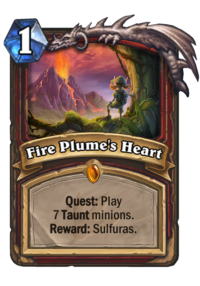
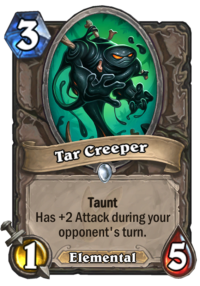
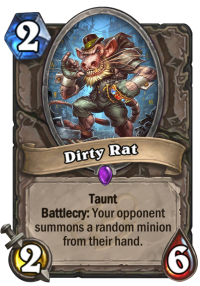
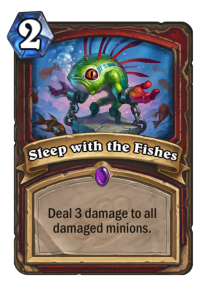
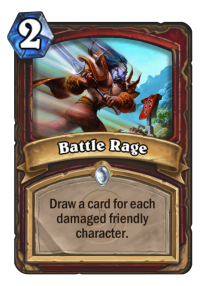
Comments